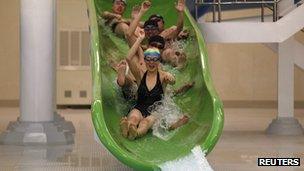Inside North Korea's space centre
- Published
- comments
Damian Grammaticas reports from the launch site in North Korea
The guards outside North Korea's satellite command centre don't smile. But then they've never had foreign journalists here before.
The previously secret site is in the countryside, half an hour outside Pyongyang. In the muddy fields nearby, troops of soldiers dig vegetable patches with hoes, and farmers work by hand, sifting the earth and planting seedlings.
Nobody would describe North Korea's mission control as imposing. It is a small, unremarkable, two-storey building, tiny compared to Nasa's Houston home in America or Russia's space command.
And there's another difference. Right in front of the building is a large cage, tall enough for a man to stand in, and several metres long. It's full of live pheasants and a deer.
It's not clear if these animals are being kept as pets, or perhaps destined to be lunch for North Korea's rocket scientists.

Journalists were told the rocket was being fuelled up
As you walk up the steps and enter you are met by a panorama painted on a wall showing a striking landscape, and North Korea's two dead autocrats - Kim Il-sung and his son Kim Jong-il - pointing, perhaps to a bright future.
But the North's secretive regime, now headed by the third of the Kim dynasty to rule here, Kim Jong-un, is opening up, for the first time.
So our group of journalists head upstairs and into the nerve centre. Sixteen technicians man the satellite command centre. Dressed in white coats, like doctors, they sit behind computer screens.
'Transparency'
On a big screen are live pictures from the launch pad, showing North Korea's rocket being fuelled up. The satellite it will carry has already been loaded on board, we are told.
Never before has the heart of North Korea's space programme been exposed to the world like this.
"Some parties insist our peaceful space programme is a missile test," says Paek Chang-ho, head of the satellite control centre.
"That's why we have invited you, to clearly show that this is a satellite launch not a ballistic missile.
"I hope you become supporters in showing the transparency of our satellite launch."
North Korea's new openness is an attempt to allay fears it is about to test missile technology that could deliver a warhead as far as America.
The United States has warned a launch would be a breach of UN Security Council resolutions that ban the North from testing missile technology. If North Korea goes ahead it could lead to UN sanctions, it has warned.
But Paek Chang-ho says in lecturing North Korea, America is behaving the way you would talk to a child.
"We are an adult," Mr Paek tells me, adding "what I am saying [to America] is do not interfere into our business".
Today the North was pressing ahead with its own business. Kim Jong-un, not yet 30 years old, was given the title of First Secretary of the Workers' Party, following in the footsteps of his father and grandfather, who ruled this land before him.

Foreign journalists were taken to view the water slides at Kim Il-sung University's swimming pool
While the Workers' Party conference was happening we were taken to see the Kim Il-sung University. I'm not quite sure why our North Korean government hosts took us there.
They took us to see the swimming pool, a giant, gleaming new complex, full of healthy, young North Koreans swimming up and down the Olympic size pool.
Others were having fun, whizzing down water slides into a plunge pool, or taking massages given by jets of water. There was even a glass lift so you didn't have to walk up some stairs to reach the high diving boards.
Intranet only
We were shown the e-library, where students sat behind computers studying - but they weren't connected to the internet, only North Korea's own limited intranet.
Seated behind one terminal was Kim Gwang-hyok, who is 31 and studying the history of North Korea's revolutionary leaders. He is two years older than his nation's new leader, but he said he trusts and believes in Kim Jong-un as he has the same qualities as his father and grandfather.
The young Kim Jong-un is now in charge of the North's rocket programme and its nuclear bombs. Despite the North's new attempts at openness, many outside North Korea find that an unsettling prospect.
- Published11 April 2012

- Published11 April 2012

- Published11 April 2012
